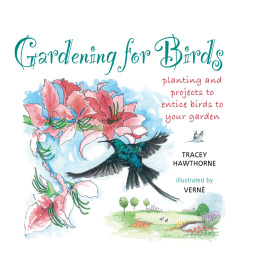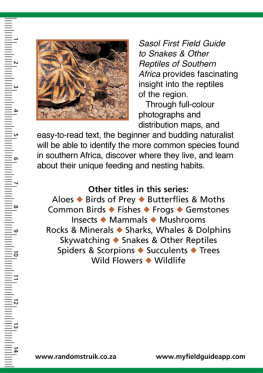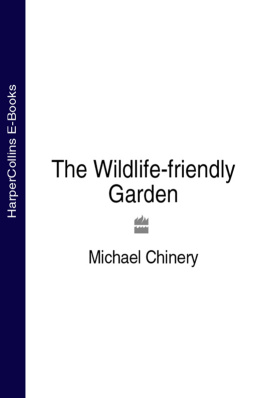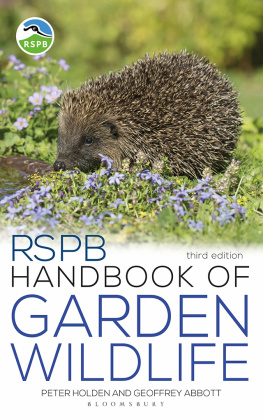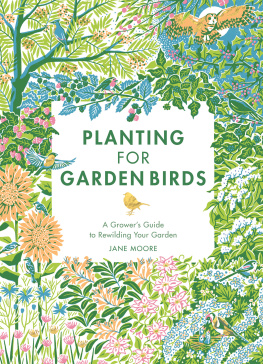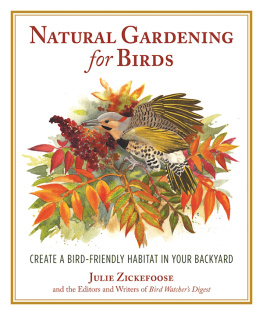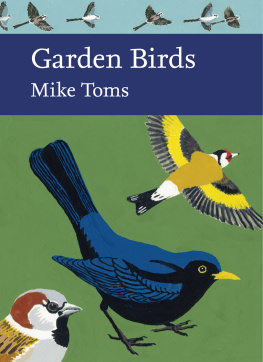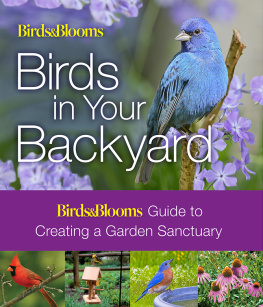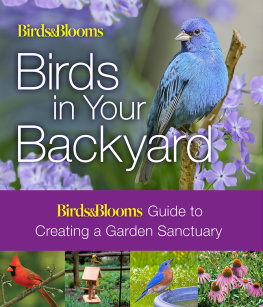Gardening for Birds
planting and projects to entice birds to your garden

TRACEY HAWTHORNE
illustrated by
VERN
Published by Struik Nature
(an imprint of Random House Struik (Pty) Ltd)
Reg. No. 1966/003153/07
Wembley Square, First Floor, Solan Road, Gardens,
Cape Town, 8001
PO Box 1144, Cape Town, 8000 South Africa
Visit www.randomstruik.co.za and join the Struik Nature Club for updates, news, events and special offers.
10 9 8 7 6 5 4 3 2 1
Copyright in text, 2014: Tracey Hawthorne
Copyright in illustrations, 2014: Vern Jordaan
Copyright in published edition, 2014:
Random House Struik (Pty) Ltd

Publisher: Pippa Parker
Editors: Helen de Villiers and Emily Bowles
Designer: Janice Evans
Proofreader: Thea Grobbelaar
Reproduction by Hirt & Carter Cape (Pty) Ltd
Printed and bound by Toppan Leefung Packaging and Printing (Dongguan) Co., Ltd, China
All rights reserved. No part of this publication may be reproduced, stored in a retrieval system, or transmitted, in any form or by any means, electronic, mechanical, photocopying, recording or otherwise, without the prior written permission of the copyright owner(s).
ISBN 978 1 92054 483 6
E-PUB 978 1 77584 133 3
E-PDF 978 1 77584 134 0

Acknowledgements
Thanks to Corn Pretorius and Andr Beaurain of the Riebeek Valley Garden Centre for so generously sharing their knowledge; to Ruan de Villiers for his sharp eye; and to Janice Evans, Helen de Villiers, Emily Bowles and the rest of the Struik team for their expert input.
Contents


Introduction
One of the greatest pleasures of owning a garden, no matter what its size, is the birds that visit it. But to attract the most birdsand the biggest variety to your garden, you need to ensure that it offers what birds look for: food, water and cover.
Although the trend is moving away from the often bird-unfriendly English country garden, many suburban landscapes are still inhospitable and hostile places for birds. Cropped lawns, clipped flowerbeds and shaped and trimmed trees offer little food for birds, few nesting opportunities and almost nowhere to hide.
To produce a landscape that supplies birds with these resources year round, you need to do some planning, and plant an assortment of plants preferably indigenous species, which are generally waterwise and familiar to local birds. And even if part of your property is intensively clipped and manicured, set aside at least one corner of it to grow relatively untended this will attract shyer species such as weavers, sparrows, bulbuls, sunbirds and barbets, among others, to your garden.
Watching birds in your garden
Enjoying the birds that visit your garden means hearing their dawn chorus or spotting them probing your lawn for food, bathing in a birdbath or busily carrying nesting materials hither and thither. Its easy, however, to make more of this hobby but beware: as many twitchers will tell you, birdwatching can be addictive!

Gearing up for watching birds
The first thing you need is a good pair of binoculars. A lightweight pair with reasonable magnification (7x or 8x) will work best, but get advice from your local camera shop if youre unsure.
Buy a reputable bird field guide preferably one for your region, because many birds tend to occur only in certain geographical ranges. Learning to identify birds can take some time, but its worth the effort. Dont look only at their coloration; note their shape (or jizz), size, markings, posture and behaviour and, of course, their calls.



It helps to draw a quick rough sketch of any unidentified bird so that you can identify it using a reference guide later.

Choose your moment. Many birds look for food in the early morning, so thats a good time to start. Sit somewhere quiet and hidden, or inside at a window, and look carefully (not through your binoculars at first) and listen.
Dress appropriately. If youre moving about in the garden yourself, wear muted colours so as to blend into the background.
Start a list. This should go quickly at first, as you note down the more common garden visitors such as pigeons and doves, weavers and sparrows. But there will come a time when youll be able to add a special to your list a seasonal (or out-of-season) visitor, a bird that for some reason has wandered from its range, or a very shy species.

South African bird habitats

The birds you see in your garden differ according to where in the country you live. Each bird prefers its own habitat, where the climate and vegetation meet its unique set of environmental requirements. These habitats reflect South Africas topography the landscape is dominated by a high plateau in the interior, surrounded by a narrow strip of coastal lowlands.
Savanna or bushveld
This largest habitat in the country is divided into moist savanna in the east and north; and arid savanna in the central west, characterised by open grasslands with scattered trees and bushes. Common plant life here includes red grass (rooigras), baobab, mopane, camel thorn and knob thorn; and you can expect to find birds such as rollers, turacos (louries) and weavers.
Forest
This smallest habitat is scattered in a series of islands towards the east. In higher-up montane forest you may see canaries, doves, turacos, weavers and the rare Cape Parrot. In coastal lowland forest you could spot rarely seen species such as Rudds Apalis, the Swamp Nightjar and Woodwards Batis.


